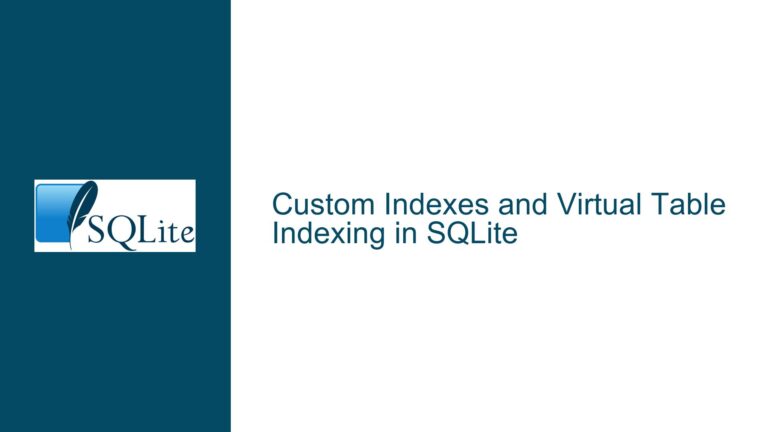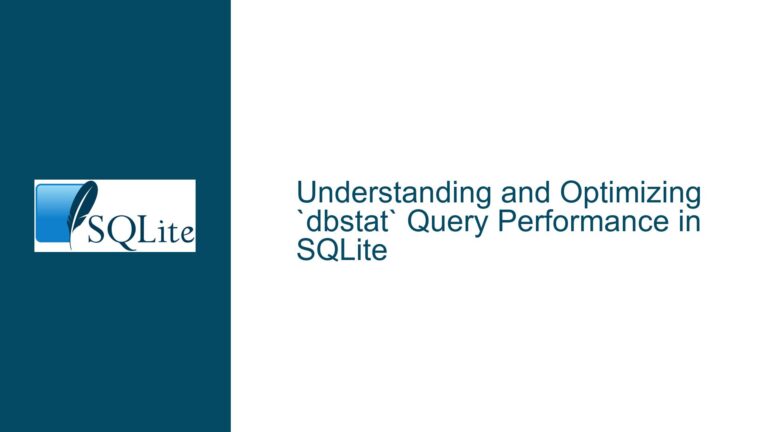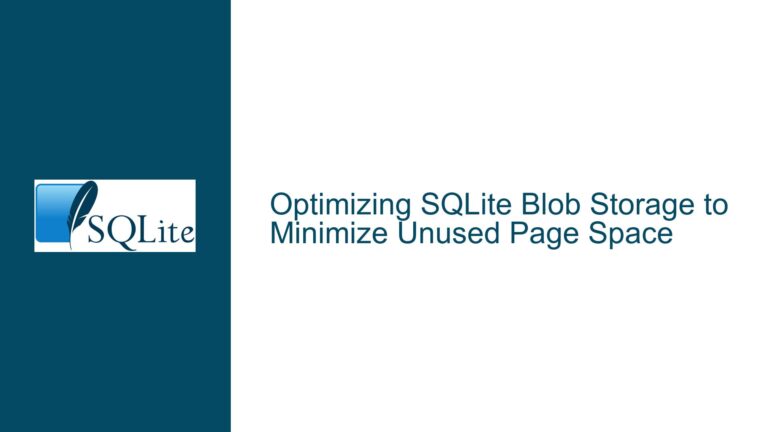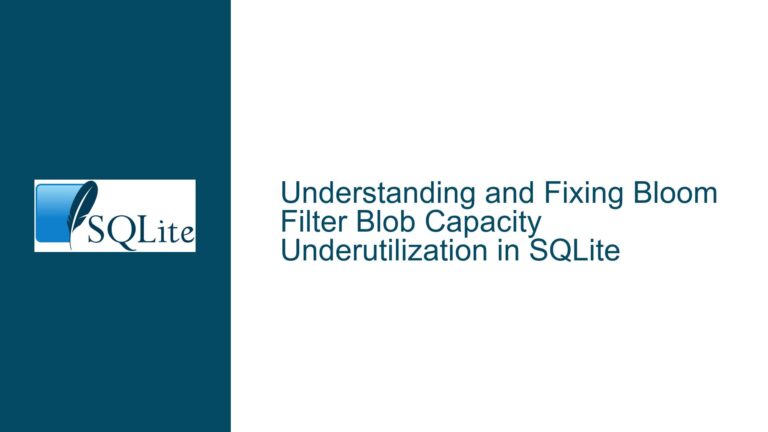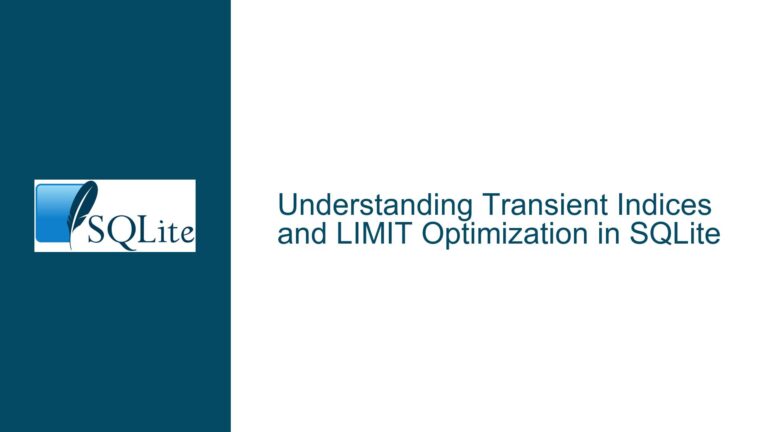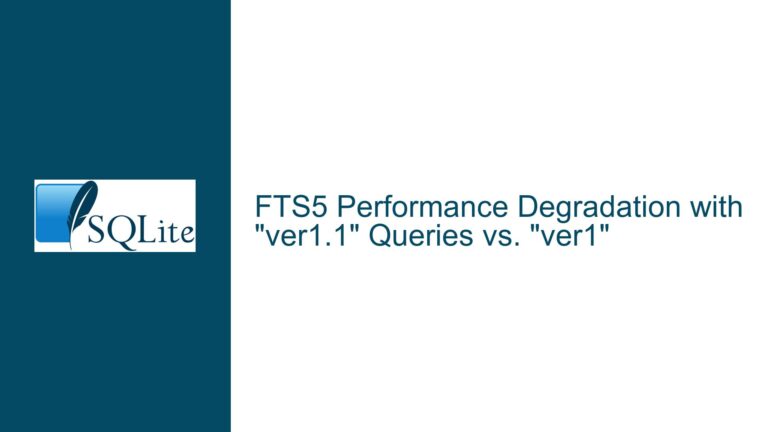Excessive WAL Growth and Slow Checkpoint Performance in SQLite WAL Mode
Understanding WAL File Expansion and Checkpoint Bottlenecks in High-Transaction Environments
Key Characteristics of the Problem Scenario
SQLite’s Write-Ahead Logging (WAL) mode is designed to improve concurrency by allowing simultaneous reads and writes. However, in workloads involving frequent small transactions—such as iterative inserts—developers may observe two critical symptoms:
- Rapid WAL file growth (e.g., expanding to 1 GB within seconds despite a small database file).
- Severe performance degradation during automatic checkpoints, which become the dominant bottleneck.
The database file remains small because checkpointing—the process of transferring changes from the WAL to the main database—is either delayed or inefficient. The WAL accumulates changes faster than checkpoints can process them, leading to runaway file growth. This behavior is counterintuitive when the logical data size (e.g., inserted rows) is modest. The root cause lies in SQLite’s page-oriented storage model and the mechanics of WAL checkpointing.
Every transaction in SQLite operates on database pages (default size 4 KB). A single row insertion may modify multiple pages:
- The table’s B-tree page where the row resides.
- Index B-tree pages for every index on the table.
- Freelist pages if the insertion triggers a page split or reuse of deleted space.
For example, inserting a 50-byte row into a table with three indexes could modify four pages (1 data + 3 index pages). Each transaction—even a single-row insert—writes all modified pages to the WAL. If transactions are not batched, this results in redundant page-level I/O amplification. A sequence of 1,000 single-row inserts could write 4,000 pages (16 MB) to the WAL. Autocheckpoints (triggered when the WAL reaches 1,000 pages by default) then process these changes, but the cumulative overhead of frequent checkpoints cripples throughput.
Architectural and Workload Drivers of WAL Inefficiency
Three primary factors contribute to this problem:
1. Transaction Granularity and Page-Level Write Amplification
When each insert is a separate transaction, SQLite must write all modified pages to the WAL and sync them (depending on PRAGMA synchronous). Small transactions maximize write amplification because index pages—often shared across many rows—are rewritten repeatedly. For instance, inserting rows into a table with a clustered index may update the same B-tree root page in every transaction, forcing it to be written to the WAL thousands of times.
2. Checkpointing Strategies and Page Coalescing Overhead
SQLite checkpoints operate in two modes:
- Passive checkpoints (automatic): Attempt to write WAL pages to the database without disrupting concurrency. These may abort if other connections are reading the database.
- Full checkpoints (manual): Block writers until all WAL pages are transferred.
During a passive checkpoint, SQLite must identify the latest version of each page in the WAL and copy it to the database. This requires traversing the entire WAL to resolve page conflicts—a process with O(N) complexity relative to the number of WAL frames. If the WAL contains many overwrites to the same pages (common with small transactions), checkpointing becomes computationally intensive.
3. Index Proliferation and Page Contention
Each index on a table adds B-tree pages that must be updated on insertion. A table with four indexes requires at least five page writes per insert (1 data + 4 index pages). Over time, these pages become fragmented, exacerbating write amplification. Secondary indexes on non-sequential keys (e.g., UUIDs) are particularly problematic because inserts scatter entries across unrelated pages, preventing locality.
Systematic Optimization Strategies for WAL and Checkpoint Performance
Addressing these issues requires a holistic approach targeting transaction patterns, schema design, and SQLite configuration:
1. Transaction Batching and Write Coalescing
While the original workload claims batching is impossible, even modest batching (e.g., 10–50 inserts per transaction) drastically reduces WAL growth. Implement a write queue that aggregates inserts in memory and flushes them in batches. Use BEGIN IMMEDIATE transactions to avoid SQLITE_BUSY errors.
Example:
queue = []
BATCH_SIZE = 50
def insert_row(row):
queue.append(row)
if len(queue) >= BATCH_SIZE:
with connection.cursor() as cur:
cur.execute("BEGIN IMMEDIATE")
for r in queue:
cur.execute("INSERT INTO data VALUES (?, ?)", r)
connection.commit()
queue.clear()
2. Schema Optimization to Minimize Page Modifications
- Remove redundant indexes: Analyze query plans with
EXPLAIN QUERY PLANand drop unused indexes. - Use covering indexes: Ensure indexes include all columns needed by queries to avoid table lookups.
- Consider
WITHOUT ROWIDtables: For tables with a fixed primary key,WITHOUT ROWIDstores data in a clustered index, reducing page splits. - Increase page size: Larger pages (e.g., 8 KB or 16 KB via
PRAGMA page_size) reduce the number of pages touched per insert. This must be set before creating the database.
3. Checkpoint Tuning and WAL Management
- Adjust the autocheckpoint threshold: Increase
PRAGMA wal_autocheckpointto 4000 (16 MB WAL) to reduce checkpoint frequency. Monitor WAL size to avoid excessive disk usage. - Manual checkpointing: Schedule checkpoints during idle periods using
sqlite3_wal_checkpoint_v2(db, SQLITE_CHECKPOINT_TRUNCATE). - Disable autocheckpoints: Use
PRAGMA wal_autocheckpoint=0and implement application-managed checkpoints.
4. Alternative Journaling Modes
If WAL mode remains unsuitable, consider:
TRUNCATEjournal mode: UnlikeDELETEmode (which zeroes the rollback journal),TRUNCATEtruncates the file, which is faster on some filesystems.MEMORYjournal mode: Stores the journal in RAM—fast but unsafe for crashes.
5. Monitoring and Diagnostics
- Track WAL metrics: Query
PRAGMA wal_statsto observe checkpoint progress and WAL frame counts. - Profile page writes: Use
PRAGMA page_count,PRAGMA freelist_countto gauge fragmentation. - Inspect query plans: Use
EXPLAIN QUERY PLANto identify unnecessary index usage.
6. Filesystem and Hardware Considerations
- Use a fast SSD: Checkpoint performance is I/O-bound.
- Place the WAL on a separate drive: Isolate WAL and database files on different disks to parallelize I/O.
- Disable disk write caching: Ensure
PRAGMA synchronous=FULLis set to prevent data loss, but verify the filesystem honors sync requests.
By methodically applying these optimizations, developers can mitigate WAL-related bottlenecks while retaining SQLite’s concurrency benefits. The optimal solution depends on the specific workload, but transaction batching and schema tuning typically yield the greatest gains.

